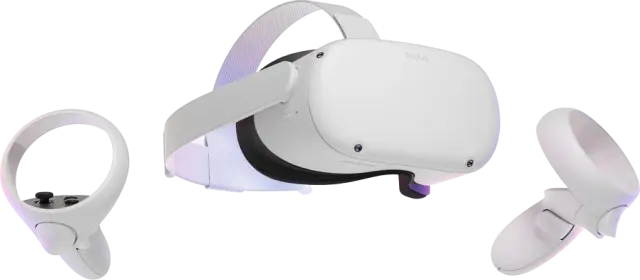The metaverse is coming… but what exactly is it? And how can you dip your toe into the world of VR? Consider this your beginner’s guide.
What exactly is the metaverse?
The term “metaverse” was first coined by science fiction writer Neal Stephenson in his 1992 book Snow Crash . It’s a vast and complex concept, but essentially, the metaverse is a network of interconnected 3D virtual worlds.
You can think of the internet as just one virtual world, whereas the metaverse is a whole collection of different dimensions to be jumped into and explored.
But if the term was coined in the early ’90s, why are we talking about the metaverse now? As you’ve probably heard, Facebook recently changed its name to Meta and pledged $10 billion to develop metaverse-related technology. At the same time, Microsoft just announced its acquisition of Activision Blizzard, one of the biggest video games companies, for a whopping $68.7 billion.
The future, it seems, is in the metaverse, and Silicon Valley’s major players are putting big bucks behind it.
What has VR technology got to do with the metaverse?
If the metaverse is a network of interconnected virtual worlds, us humans need a way to explore these realities. This is where VR technology comes in.
Virtual reality (VR) is a computer-generated environment that simulates objects and experiences that feel remarkably real. Some of the most common applications of virtual reality include entertainment (video games), education (virtual training programs), and business.
To access these virtual environments, we need VR technology. With virtual reality headsets, helmets, or glasses, we can be immersed in a virtual world—so realistically that we feel like we’re actually there.
Getting started with VR technology
If you’re keen to jump into the world of VR, here are 3 tips to help you get started.
1) Opt for a standalone VR headset
Standalone VR headsets connect wirelessly to the internet and don’t require any other external equipment. Standalone VR technology, like the Oculus Quest 2, offers much more flexibility and tends to be more affordable, making it a great place to start for newbies.
2) Get to know your specs
When delving into VR, it’s important to be familiar with certain technical considerations. Research things like:
Resolution per eye (the number of pixels a VR headset is able to display). For a first-rate experience, you want between 1700 x 1440 per eye and 1832 x 1920 per eye.
Field of view (FOV)—the range that’s visible when you’re wearing the headset. We recommend a FOV between 100 and 110 degrees.
Refresh rate—how fast your headset can show images, measured in frames per second (fps). Aim for 90 fps and above.
3) Consider your surroundings
What will you use your VR headset for, and where will you use it? If your virtual experience requires movement, make sure you’ve got enough space to move around safely without collisions.
A closer look at the Oculus Quest 2
It’s often touted as one of the best options on the market—but is the Oculus Quest 2 worth it? Let’s take a look.

Oculus Quest 2 specs
The Oculus Quest 2 is a light, comfortable headset for immersive VR play. Weighing just 0.5 kg, it comes with integrated audio, 2 Oculus touch controllers, and a single fast-switching LCD display, and delivers 1832 x 1920 pixels per eye. Most importantly, the Oculus Quest 2 operates as a standalone device, making it ideal for beginners. View the full set of technical specs for the Oculus Quest 2 here.
As it’s a standalone device, you might be wondering: does the Oculus 2 require Wi-Fi? The answer is yes, the Oculus Quest 2 will require a Wi-Fi connection to use and access most features and content.
And how much uninterrupted game time do you get with this headset? The Oculus Quest 2 charge time is between 2 and 2.5 hours (from empty to full), and the Oculus Quest 2 battery life stands between 2 and 3 hours.
Oculus Quest 2 vs. other virtual reality glasses
Weighing up the Oculus Quest 2 vs. other virtual reality glasses? Here’s a comparison table to help you.
Resolution per eye: 1832 x 1920
Max screen refresh rate/Hz: 72
Field of view/ degrees: n/a
Resolution per eye: 1280 x 1440
Max screen refresh rate/Hz: 80
Field of view/ degrees: 110
Resolution per eye: 1080 x 1200
Max screen refresh rate/Hz: 90
Field of view/ degrees: 110
In all, the Oculus Quest 2 is a beginner-friendly VR headset offering a first-class virtual reality experience. And, if you’re not ready to buy, you can get it on a monthly basis for as little as €24.90 per month. Whatever you decide, an exciting metaverse awaits…


